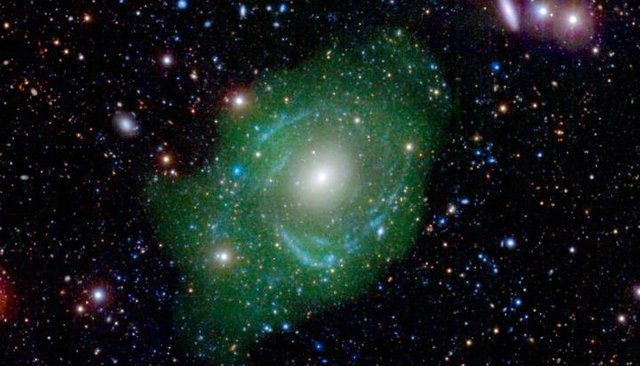
A 250 million light years , there is an area of the universe that was considered quiet so far, but just appeared a strange galaxy possibly formed by parts of others.
A new study to be published in the Astrophysical Journal reveals the secret of UGC 1382, a galaxy originally thought old , small and conventional. Instead , with the combined use of different telescopes and observatories NASA has found that the galaxy is 10 times larger than previously thought and , unlike other galaxies , the bowels are younger than the parties Outside , almost as if it had been built with spare parts.
" This rare galaxy ' Frankenstein ' was formed and is able to survive because it is located in a small quiet suburban neighborhood of the universe , without the hassles from the bustle of the busiest areas" said study co-author Mark Seibert of the Observatories of the Carnegie Institution for Science in Pasadena , California. "It is so delicate that a slight push of a neighbor could disintegrate it "
Seibert and Lea Hagen, a graduate student at Pennsylvania State University , came up with this galaxy by accident. They had been looking for stars which are formed in elliptical galaxies , which do not rotate and are more three-dimensionally shaped ball and the flat disc . Astronomers originally thought UGC 1382 was one of those .
But looking at pictures of galaxies in ultraviolet light through data Galaxy Evolution Explorer ( GALEX ) spacecraft , a giant began to emerge from the darkness , reports NASA.
The researchers analyzed data from the galaxy of other telescopes : the Sloan Digital Sky Survey, the Two Micron All- Sky Survey ( 2MASS ), the Wide-field Infrared Survey Explorer (WISE ), the Very Large Array of the National Radio Astronomy Observatory and du Pont Telescope Carnegie at the Las Campanas Observatory . Optical and infrared observations of light from the telescopes allowed researchers to construct a new model of this mysterious galaxy.
So , it turns out that UGC 1382 measures about 718,000 light years in diameter , more than seven times wider than the Milky Way. This is one of the three largest galaxies ever discovered isolated disc, according to the study . This galaxy is a rotating disk of gas of low density. The stars were not formed here very quickly because the gas is widespread.
But the biggest surprise was to examine the relative ages of the components of the galaxy. In others, the innermost portion is formed first and contains the oldest stars . As it grows the galaxy, outer areas appear with younger stars . Not so with UGC 1382 .
" The center of UGC 1382 is actually younger than the spiral disk around it ," Seibert said. "This is like finding a tree whose inner growth rings are younger than the outer rings ."
The only galactic structure may be the result of separate entities which bind , rather than a single entity that grows outward . In other words, two parts of the galaxy evolved separately before the merger , each with its own history.
At first , you probably have a small group of galaxies dominated by gas and dark matter , which is an invisible substance that makes up about 27 percent of all matter and energy in the universe . Later, a lenticular galaxy, a rotating disk without spiral arms, would have formed in the vicinity. At least 3,000 million years ago , smaller galaxies may have fallen into orbit around the lenticular galaxy , time to settle in the large disk seen today.